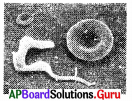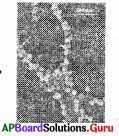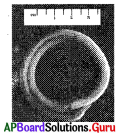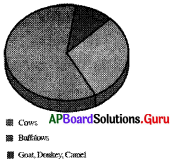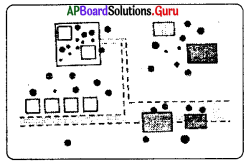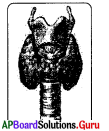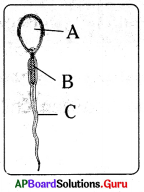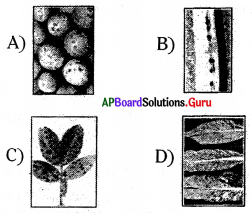Practice the AP 10th Class Social Bits with Answers 2nd Lesson అభివృద్ధి భావనలు on a regular basis so that you can attempt exams with utmost confidence.
AP Board 10th Class Social Bits 2nd Lesson అభివృద్ధి భావనలు
బహుళైచ్ఛిక ప్రశ్నలు :
1. క్రింది పట్టికను పరిశీలించి, a నుండి d ప్రశ్నలకు సమాధానాలు రాయండి.
2013లో భారతదేశం, దాని పొరుగు దేశాలకు సంబంధించిన కొన్ని వివరాలు
a) పై పట్టిక ఆధారంగా మానవాభివృద్ధి సూచికలో అతి తక్కువ స్తానం పొందిన దేశాన్ని గుర్తించుము.
A) భారతదేశం
B) శ్రీలంక
C) మయన్మార్
D) నేపాల్
జవాబు:
D) నేపాల్
b) భారతదేశంతో పోల్చినప్పుడు పాకిస్తాన్ ఏ అంశంలో వెనుకబడి లేదు?
A) తలసరి ఆదాయం
B) పాఠశాల విద్యలో ఉండే సం||రాలు
C) బడిలో గడిపిన సం||రాలు
D) మానవాభివృద్ధి సూచిక
జవాబు:
C) బడిలో గడిపిన సం||రాలు
c) ఏ దేశం యొక్క ఆయుః ప్రమాణం పాకిస్తాన్తో సమానంగా ఉంది?
A) శ్రీలంక
B) భారతదేశంలో
C) మయన్మార్
D) నేపాల్
జవాబు:
C) మయన్మార్
d) శ్రీలంకతో పోల్చినపుడు భారతదేశం ఏ అంశంలో వెనుకబడి ఉన్నది?
A) తలసరి ఆదాయం
B) మానవాభివృద్ధి సూచిక
C) ఆయుః ప్రమాణం
D) అన్ని అంశాలతో
జవాబు:
D) అన్ని అంశాలతో
![]()
2. మౌలిక ఆరోగ్య సదుపాయాలు, విద్యా సౌకర్యాలు తగినంతగా ఉన్నపుడు ……….
A) మానవాభివృద్ధి సూచిక స్థాయి పెరుగుతుంది.
B) శిశు మరణాలు తక్కువగా ఉంటాయి.
C) మానవాభివృద్ధి సూచిక స్థాయి తగ్గుతుంది.
D) సామాజిక అవసరాలు తీరతాయి.
జవాబు:
A) మానవాభివృద్ధి సూచిక స్థాయి పెరుగుతుంది.
3. క్రింది వాటిలో అతి సంక్లిష్టమైన అంశము ………………
A) ఆర్థికాభివృద్ధి
B) అభివృద్ధి
C) పెరుగుదల
D) ఏదీకాదు
జవాబు:
B) అభివృద్ధి
4. ఆదాయరీత్యా ప్రస్తుతము భారతదేశపు స్థితి ………..
A) ఎక్కువ ఆదాయం గల దేశం
B) తక్కువ ఆదాయం గలది
C) మధ్యస్ల ఆదాయం గలది
D) అత్యధిక ఆదాయం గల దేశము
జవాబు:
C) మధ్యస్ల ఆదాయం గలది
5. విభిన్న వ్యక్తులకు అభివృద్ధి పట్ల విభిన్న భావనలు ఉండుటకు కారణము ……….
A) వ్యక్తులు వేరు కాబట్టి
B) జీవన పరిస్థితులు వేరు కాబట్టి
C) అభిప్రాయాలలో భేదాలు ఉండడం
D) ఆలోచనలో మార్పు ఉండడము
జవాబు:
B) జీవన పరిస్థితులు వేరు కాబట్టి
6. క్రింది వానిలో సరికానిది.
A) గ్రామీణ కార్మికులు మెరుగైన కూలీని కోరుతారు.
B) వర్షాధార రైతులు సరియైన వర్షాలు కోరుతారు.
C) ధనిక రైతులు గ్రామాల్లోనే స్థిరపడాలని కోరుతారు.
D) ధనిక కుటుంబ అమ్మాయి స్వేచ్ఛను కోరుతుంది.
జవాబు:
C) ధనిక రైతులు గ్రామాల్లోనే స్థిరపడాలని కోరుతారు.
7. రాష్ట్రాల బడ్జెట్ లో చదువుపై ఎక్కువ ఖర్చు చేస్తున్న రాష్ట్రం
A) హిమాచల్ ప్రదేశ్
B) బీహార్
C) గుజరాత్
D) కర్ణాటక
జవాబు:
A) హిమాచల్ ప్రదేశ్
![]()
8. 2013 మానవాభివృద్ధి సూచిక ప్రకారం భారతదేశ స్థానము ………
A) 157
B) 136
C) 146
D) 149
జవాబు:
B) 136
9. భారతదేశంలోని ఈ రాష్ట్రంలో పాఠశాల విద్యా విప్లవం ప్రారంభమయినది ………..
A) మహారాష్ట్ర
B) పంజాబ్
C) హిమాచల్ ప్రదేశ్
D) ఉత్తర ప్రదేశ్
జవాబు:
C) హిమాచల్ ప్రదేశ్
10. మానవాభివృద్ధి సూచిక (HDI) పరిగణనలోకి తీసుకొనే అంశాలు ………
A) పోషకాహారం
B) విద్య
C) వైద్యం
D) పైవన్నీ
జవాబు:
D) పైవన్నీ
11. లింగ వివక్షత అనగా ……….
A) స్త్రీలు మరియు పురుషులు
B) స్త్రీలు మాత్రమే
C) పురుషులు మాత్రమే
D) స్త్రీలను అసమానంగా చూడడము
జవాబు:
D) స్త్రీలను అసమానంగా చూడడము
12. క్రింది పట్టికను పరిశీలించి i నుండి iv ప్రశ్నలకు సమాధానాలు గుర్తించండి.
2013 లో భారతదేశం, దాని పొరుగు దేశాలకు సంబంధించిన కొన్ని వివరాలు
i) అత్యల్ప తలసరి ఆదాయం గల దేశం
A) మయన్మార్
B) బంగ్లాదేశ్
C) శ్రీలంక
D) నేపాల్
జవాబు:
D) నేపాల్
ii) ఆయుఃప్రమాణం ఒకే విధంగా ఉన్న దేశాలేవి?
A) భారతదేశం, మయన్మార్
B) మయన్మార్, పాకిస్తాన్
C) బంగ్లాదేశ్, నేపాల్
D) పాకిస్తాన్, భారతదేశం
జవాబు:
B) మయన్మార్, పాకిస్తాన్
iii) అత్యధిక తలసరి ఆదాయం గల దేశం
A) పాకిస్తాన్
B) భారతదేశం
C) శ్రీలంక
D) మయన్మార్
జవాబు:
C) శ్రీలంక
iv) మానవ అభివృద్ధి సూచికలో ఒకే ర్యాంకును కలిగిన దేశాలేవి?
A) భారతదేశం, పాకిస్తాన్
B) మయన్మార్, బంగ్లాదేశ్
C) బంగ్లాదేశ్, నేపాల్
D) పాకిస్తాన్, బంగ్లాదేశ్
జవాబు:
D) పాకిస్తాన్, బంగ్లాదేశ్
13. మానవ అభివృద్ధి నివేదికను ప్రచురించు సంస్థ ఏది?
A) U.N.D.P
B) IMF
C) IBRD
D) WTO
జవాబు:
A) U.N.D.P
![]()
14. క్రింది మానవాభివృద్ధి నివేదిక – 2013ను పరిశీలించి i, ii ప్రశ్నలకు సమాధానాలు గుర్తించుము.
i) మానవాభివృద్ధి నివేదిక – 2013 ప్రకారం ఈ దేశం మంచి స్థితిలో ఉంది.
A) భారతదేశం
B) పాకిస్తాన్
C) శ్రీలంక
D) నేపాల్
జవాబు:
C) శ్రీలంక
ii) ఆయు:ప్రమాణం విషయంలో భారతదేశం కంటే మంచి స్థితిలోనున్న దేశాలు –
A) పాకిస్తాన్, శ్రీలంక
B) నేపాల్, శ్రీలంక
C) శ్రీలంక, పాకిస్తాన్
D) పాకిస్తాన్, నేపాల్
జవాబు:
B) నేపాల్, శ్రీలంక
15. 2018 మానవాభివృద్ధి సూచికలో మెరుగైన స్థానంలోగల దేశం
A) నేపాల్
B) పాకిస్తాన్
C) మయన్మార్
D) శ్రీలంక
జవాబు:
D) శ్రీలంక
16. ఈ క్రింది ఏ అంశం ఆధారంగా ఒక రాష్ట్రాన్ని వెనుక బడిన రాష్ట్రంగా పేర్కొనవచ్చు?
A) ఎక్కువ శిశు మరణాలు
B) తక్కువ అక్షరాస్యతా శాతం
C) తక్కువ నికర హాజరు శాతం
D) పైవన్నీ
జవాబు:
D) పైవన్నీ
17. క్రింది వానిలో వేటిని UNDP అభివృద్ధికి కొలమానంగా తీసుకున్నది?
A) వలస
B) ప్రజల ఆరోగ్యస్థాయి
C) తలసరి ఆదాయం
D) Bమరియు C
జవాబు:
D) Bమరియు C
18. హిమాచల్ ప్రదేశ్ లో అధిక అక్షరాస్యతకు కారణం కానిది
A) విద్య ఉచితం లేదా తల్లిదండ్రులకు నామమాత్రపు ఖర్చు
B) కనీస సౌకర్యాలు కల్పించడం
C) ఉపాధ్యాయుల నియామకం చేయడం
D) పాఠశాలలో కఠిన శిక్ష
జవాబు:
D) పాఠశాలలో కఠిన శిక్ష
19. పాఠశాల విద్యా విప్లవం క్రింది రాష్ట్రంలో సంభవించింది.
A) అసోం
B) హిమాచల్ ప్రదేశ్
C) సిక్కిం
D) ఆర్థికాభివృద్ధి
జవాబు:
B) హిమాచల్ ప్రదేశ్
20. విద్యకోసం ఒక్కొక్క విద్యార్థిపై అధిక మొత్తం ఖర్చు చేసిన రాష్ట్రం
A) హిమాచల్ ప్రదేశ్
B) ఆంధ్ర ప్రదేశ్
C) బీహార్
D) ఉత్తర ప్రదేశ్
జవాబు:
A) హిమాచల్ ప్రదేశ్
21. హిమాచల్ ప్రదేశ్ రాష్ట్రము మానవాభివృద్ధిలో ముందున్నది ఎందుకంటే
i) తక్కువ శిశు మరణాలు
ii) తక్కువ అక్షరాస్యత శాతం
iii) ఎక్కువ నికర హాజరు శాతము
A) (i) మరియు (ii)
B) (1) మరియు (iii)
C) (ii) మరియు (iii)
D) (i), (ii) మరియు (iii)
జవాబు:
B) (1) మరియు (iii)
22. దేశాలను వర్గీకరించడానికి ప్రపంచ బ్యాంక్ చేత ఉపయోగించబడిన సూచిక
A) మానవ అభివృద్ధి
B) జాతీయాదాయం
C) తలసరి ఆదాయం
D) తమిళనాడు
జవాబు:
C) తలసరి ఆదాయం
![]()
23. క్రింది వాక్యాలను పరిగణించండి.
i) వేరు వేరు వ్యక్తులకు వేరు వేరు అభివృద్ధి లక్ష్యాలు ఉండవచ్చు.
ii) ఒకరికి అభివృద్ధి అయినది మరొకరికి కూడా అభివృద్ధి అవుతుంది.
పై వాక్యా లలో సరైనది ఏది?
A) i) మాత్రమే
B) ii) మాత్రమే
C) i) మరియు ii)
D) రెండూ కావు
జవాబు:
A) i) మాత్రమే
